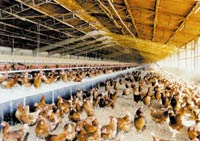Wednesday, 21 June 2006
The Australian Poultry CRC and the Queensland Department of Primary Industries and Fisheries have started a collaborative project to address the issue of safe and sustainable re-use of chicken litter across production cycles.
The new project will deliver hard scientific data that will help the chicken meat industry manage an important resource (bedding material) in a manner that ensures minimal impact to the environment as well as food safety and a quality end-product.
The two-year project will consist of both on-farm and laboratory work, concentrating on what happens to bacteria levels when the used bedding material, known as litter, is piled while the shed is cleaned for the next flock. At present, the sources for bedding material are limited and expensive. At the same time, there is pressure to ensure that litter is used in a safe and sustainable manner.
One option of reducing the pressure on industry and the environment (in terms of both obtaining bedding and then disposing of the litter) is to re-use the litter for more than one production cycle. There is evidence that aged litter and the piling process are both effective means of reducing the levels of potentially harmful bacteria.
At the end of the production cycle, litter from a meat chicken flock contains large numbers of bacteria. As with all material contaminated with faeces, litter can contain bacteria that are a risk to public health, but it is also a valuable resource containing important nutrients such as nitrogen and phosphorous.
Most meat chickens in Australia are grown on bedding material within a shed that provides optimal environmental conditions in terms of warmth and air flow. The bedding material is an important part of the system, helping to soak up and absorb the chicken droppings. The typical bedding materials used in Australia include wood shavings, sawdust, shredded paper and rice hulls.


